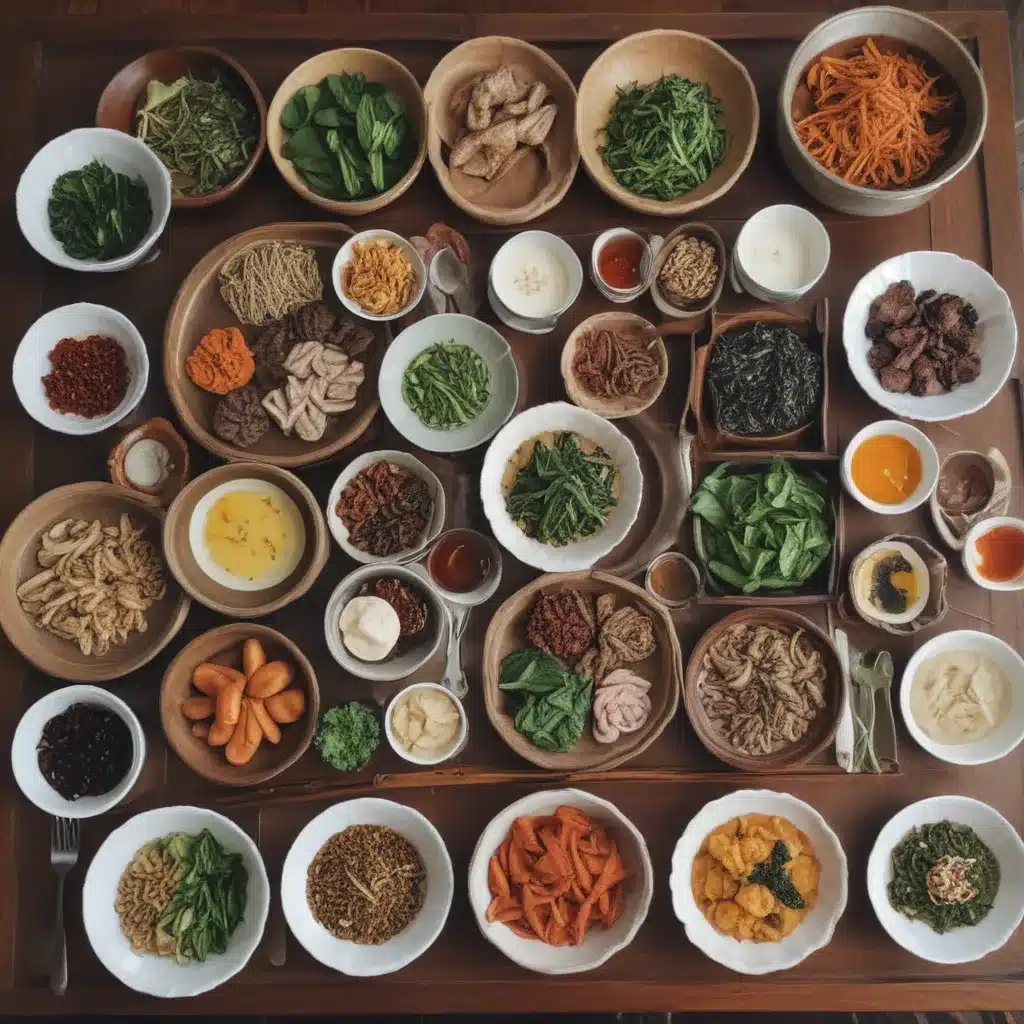
The Enchanting World of Korean Temple Cuisine
As I stepped into the elegant dining room of Balwoo Gongyang in Seoul, the serene atmosphere immediately enveloped me. This wasn’t your typical Korean restaurant – this was a culinary sanctuary dedicated to the ancient wisdom of Buddhist temple cuisine. [1]
I had the privilege of sitting down with Chef Ji Young Kim, the mastermind behind this Michelin-starred marvel. With her infectious enthusiasm, she began to unravel the fascinating story of Korean temple food – a journey that would forever change my understanding of mindful eating.
Elevating the Simple to the Sublime
“Korean temple food is quite different from the rest of Korean cuisine,” Chef Ji Young explained, her eyes sparkling. “We don’t use any animal products, seafood, or the five pungent ingredients – onions, garlic, leeks, chives, and green onions.” [1] This revelation immediately piqued my curiosity. How could such a restrictive diet result in dishes that have earned global acclaim?
The answer lies in Chef Ji Young’s unwavering dedication and culinary ingenuity. “When I first started learning temple food, I thought it was a bit bland,” she admitted. “But after immersing myself in different cuisines, I came back to it with a newfound appreciation.” [1] Through her mastery of fermentation, pickling, and dehydration, she’s transformed the humble temple fare into a gastronomic masterpiece.
The Art of Mindful Eating
At the heart of Korean temple cuisine lies a profound philosophy – eating as a meditative practice. “Balwoo Gongyang refers to the act of eating as part of practicing discipline and self-control,” Chef Ji Young explained. “You take only what you need, without any waste, and approach the food with gratitude and awareness.” [1]
This mindset extends to every aspect of the dining experience. “When you have rice, think about how the farmer used their hands 88 times before it could be harvested,” she said, her voice brimming with reverence. “It’s about understanding the hard work and generosity of so many who came before you to bring this food to the table.” [1]
Seasonal Sensations and Preservation Techniques
As I listened, I was struck by the profound seasonality of Korean temple food. “Depending on the season, the same ingredient can have a completely different nature,” Chef Ji Young revealed. “The summer radish is firm and bland, while the winter radish is soft and flavorful.” [1] To adapt to these fluctuations, the temple cooks have mastered the art of preservation, utilizing techniques like pickling, fermenting, and dehydrating to extend the life of their precious ingredients.
The result is a culinary tapestry that seamlessly weaves together the rhythm of nature and the wisdom of the ages. “In the past, when temples were located in the mountains, ingredients were scarce,” Chef Ji Young noted. “That’s why these preservation methods were so crucial – to ensure no food went to waste.” [1]
A Feast for the Senses
As the interview progressed, Chef Ji Young shared a mouthwatering array of temple food dishes, each one a masterpiece in its own right. From the delicate Omija Tea, with its perfect balance of sweet, salty, bitter, sour, and umami, to the Stuffed Lotus Root Kimchi, bursting with the tangy-sweet flavors of aged persimmon vinegar, I was captivated by the complexity and artistry on display. [1]
But it was the act of eating these dishes that truly transported me. “You’re not just tasting the food, but engaging all five senses,” Chef Ji Young explained. “Look at the ingredients, smell the aromas, feel the textures, listen to the crunch, and savor each bite with reverence.” [1] It was a revelation, a culinary meditation that left me both nourished and enlightened.
A Journey of the Senses
As I left Balwoo Gongyang, my senses still humming with the experience, I couldn’t help but reflect on the profound impact of Korean temple cuisine. This was no mere meal – it was a journey of the senses, a celebration of the rhythms of nature, and a testament to the transformative power of mindful eating.
In a world often consumed by excess and distraction, Chef Ji Young and her team have created a sanctuary where the simple act of nourishing the body becomes a pathway to nourishing the soul. [1] It’s a reminder that the true essence of food lies not in its mere sustenance, but in the way it connects us to the world around us and the innate wisdom that lies within.
So, the next time you sit down to a meal, I invite you to slow down, savor each bite, and connect with the sacred energy that infuses every morsel. For in the enchanting world of Korean temple cuisine, the true feast lies not just on the plate, but in the mindful journey of the senses.
[1] Knowledge from https://www.kaveyeats.com/what-is-korean-temple-food-chef-ji-young-kim
[2] Knowledge from https://thelittleveggiekorean.com/korean-temple-food/
[3] Knowledge from http://blogs.evergreen.edu/comalt-meghan/week-8-project-update-chefs-table-fermentation-and-temple-food/
[4] Knowledge from https://tastecooking.com/the-korean-temple-food-not-seen-on-netflix/
[5] Knowledge from https://www.reddit.com/r/vegan/comments/1472zv9/free_vegan_meal_at_a_buddhist_temple/
[6] Knowledge from https://www.scmp.com/magazines/post-magazine/food-drink/article/3163386/korean-temple-food-and-buddhist-ethos-home-how
[7] Knowledge from https://www.reddit.com/r/KoreanFood/comments/oa99gg/vegan_korean_buddhist_cuisine_at_%EB%B0%9C%EC%9A%B0%EA%B3%B5%EC%96%91_in_seoul/
[8] Knowledge from http://minapark.com/journal/2017/koreantemplecuisineintro
